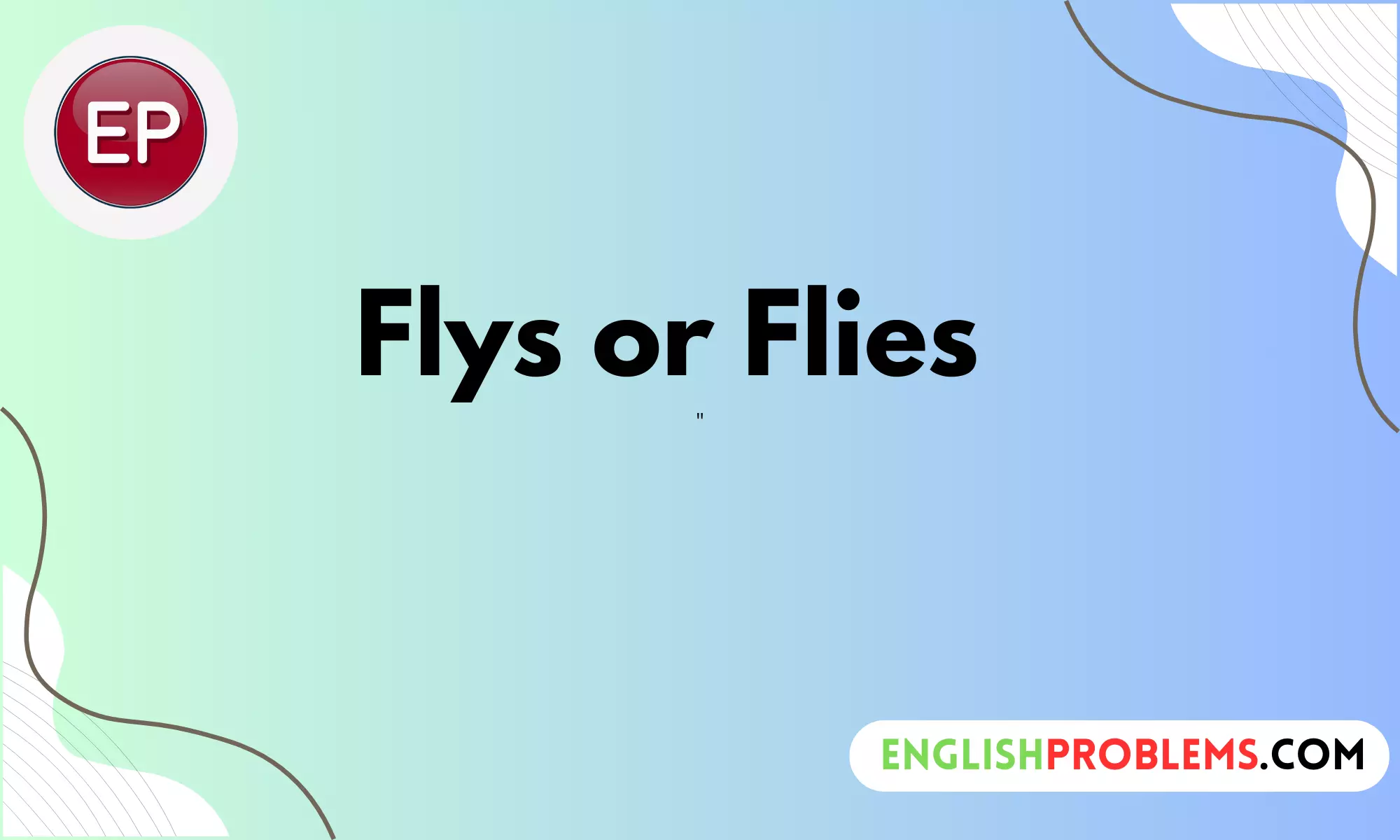Last updated on September 9th, 2024 at 08:20 am
In the world of English grammar, a common source of confusion arises between the terms “flys” vs “flies” Both words seem similar but serve different purposes and follow distinct rules.
In this comprehensive guide, we’ll delve into the intricacies of these terms, exploring their correct usage, grammar rules, and practical tips to help you use them accurately.
Understanding the Basics
Definition and Meaning
Fly (noun and verb): The word “fly” serves dual purposes in English. As a noun, it refers to the small, often annoying insect known for its ability to hover and dart about. For example, “The fly buzzed around the room.”
As a verb, “fly” describes the action of moving through the air. For instance, “Birds fly south for the winter.” Understanding this distinction is crucial for grasping the difference between “flies” or “flys“.
Plural Form of Fly: When referring to more than one of these insects, the plural form is “flies.” This is a standard rule in English grammar where nouns ending in “y” change to “ies” in the plural form. For instance, “The room was swarming with flies.”
Common Misconceptions
Flys vs. Flies: Many people mistakenly use “flys” instead of “flies” when referring to the insect. This confusion often stems from misunderstanding English pluralization rules or simply mistyping.
Historical Usage: Historically, “flys” was an accepted plural form. However, over time, standard English usage evolved, and “flies” became the correct form. The shift reflects broader trends in English grammar and pronunciation.
Detailed Breakdown
Grammar Rules
Nouns and Plurals:
- Rule for Forming Plurals: In English, nouns ending in “y” generally change to “ies” to form their plural. This rule applies to “fly”:
- Singular: Fly
- Plural: Flies
- Examples:
- Singular: “A fly landed on the cake.”
- Plural: “The flies were attracted to the garbage.”
Verbs:
- Conjugation of the Verb “To Fly”: The verb “fly” undergoes various changes depending on the tense:
- Present Simple: fly (e.g., “I fly to New York.”)
- Third Person Singular: flies (e.g., “She flies every weekend.”)
- Present Continuous: flying (e.g., “They are flying to Paris.”)
- Past Simple: flew (e.g., “He flew to London yesterday.”)
- Past Participle: flown (e.g., “They have flown many times.”)
Contextual Usage
Examples in Sentences:
- “Flies” as a Noun:
- “The flies in the kitchen were annoying.”
- “We need to get rid of those flies before they spread.”
- “Flies” as a Verb:
- “The drone flies high above the city.”
- “She flies to meet her clients every month.”
Exceptions and Special Cases
Irregular Forms
Irregular Plural Forms: While “flies” is the plural form of “fly,” English contains many irregular plural forms. Here are a few examples for context:
SingularPluralGooseGeeseMouseMiceToothTeeth
Comparison with Similar Words: Similar patterns exist with words like “die” (plural: “dice”) and “loaf” (plural: “loaves”). Understanding these exceptions helps in mastering English pluralization rules.
Compound Words
Words Including “Fly”: Some compound words use “fly” and follow different pluralization rules:
Compound WordSingularPluralButterflyButterflyButterfliesDragonflyDragonflyDragonflies
Examples in Sentences:
- “I saw a beautiful butterfly in the garden.”
- “Dragonflies are often found near water bodies.”
Practical Tips for Correct Usage
Mnemonics and Memory Aids
Simple Tricks to Remember:
- Remember the Rule: For nouns ending in “y,” change “y” to “ies” for plurals. Think of “flies” as a direct application of this rule.
- Visual Aids: Picture a single fly buzzing around and multiple flies causing a nuisance. This visual can help you recall the correct plural form.
Common Mistakes and How to Avoid Them
Frequently Made Errors:
- Using “Flys” Incorrectly: Some may use “flys” when referring to the insect, perhaps due to familiarity with the verb form or simple oversight.
- Misapplying Rules: Confusing “flies” (plural noun) with “flies” (verb form) can lead to mistakes.
Strategies to Check and Correct Usage:
- Proofreading: Always review your text for proper noun and verb forms.
- Grammar Tools: Utilize online grammar checkers that highlight such errors.
Quiz and Practice
Interactive Quiz
Test your understanding with this short quiz:
- Which is correct?
- A) The flys were everywhere.
- B) The flies were everywhere.
- Select the correct verb form:
- “She _____ (fly) to the conference last week.”
Answers:
- B) The flies were everywhere.
- flew
Practice Exercises
Fill-in-the-Blank Sentences:
- “The ____ (fly/flies) landed on the bread.”
- “He ____ (fly/flies) to California every month.”
Encouragement: Write your own sentences using both forms to reinforce your understanding.
Conclusion
Summary
The distinction between “flys” and “flies” is rooted in basic English grammar rules. “Flies” is the correct plural form for the noun and also serves as the third-person singular form of the verb “to fly.” By mastering these rules, you enhance your writing clarity and accuracy.
Final Tips
- Reinforce Key Takeaways: Remember, “flies” is always correct for multiple insects and the verb form in third-person singular.
- Practice Regularly: Frequent use and practice will help solidify your grasp of these terms.
Call to Action
Share your experiences or questions about “flys” vs. “flies” in the comments below. Engage with others to test your understanding and clarify any doubts!

Emily Johnson is a seasoned writer with a sharp eye for grammatical accuracy. Her detailed guides and helpful tips make her a trusted source for anyone looking to enhance their understanding of English grammar and elevate their writing.










